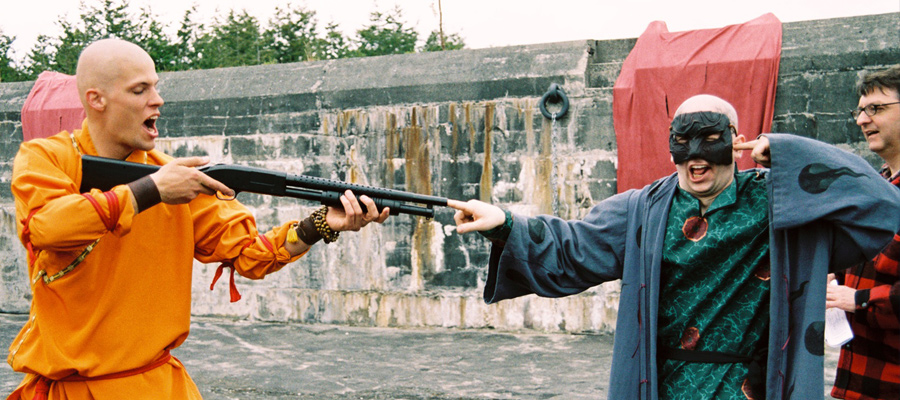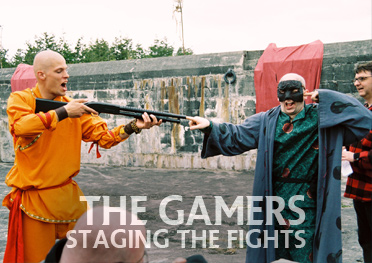
BY KEVIN INOUYE
What’s a fantasy series without swords, or RPG without combat? Sure, it’s doable, but I think we’d all sense something missing without the occasional bit of action. The Gamers series and other projects by Dead Gentlemen and Zombie Orpheus are no different, with combat and weaponry playing key parts in the story, and even sometimes characters of their own (like the talking sword in JourneyQuest).
But these are not action movies. They’re comedies first, dramas second, and probably world-building exercises third, rife as they are with open-source potential for fan contributions or RPG spin-offs. Action maybe comes fourth.
I don’t think this precludes the potential for action/stunt oriented content within the world of Fartherall, but it’s a part of the core GAMERS franchise, and the aesthetic of several primary creators. Exceptions include some Demon Hunters projects that might get a bit darker, and The Gamers: Natural One, where they worked with James Mark and stunt team 2x Entertainment to put together a solid action sequence, but the features are true to their comedy improv roots. As fight coordinator and an armorer for The Gamers: Dorkness Rising and GAM3RS: Hands of Fate, this dictated my choices in several ways.
This grew out of grass-roots community effort. Roles were played by friends, kickstarter contributors, crew members, volunteers – in Dorkness Rising, we had an some theatrical stage combatants but we lacked full-time professional stuntpersons and stunt doubles (except when we needed duplicates, as the new party met the zombie version of the old). That includes me; this was my first feature film, and just a hobby at the time. We had mostly steel weapons and armor for the main characters (not the movie-standard mix of aluminum, rubber, steel, and F/X duplicates) and little preproduction training. We certainly benefited from Brian and Christian’s ability to move well, and from casting a former wushu competitor as Mort Kemnon, but that wasn’t what got them cast. On set, fights were typically the last thing on the shot list, which sometimes meant being delegated to the last half hour of daylight to kill off a dozen goblins. We built props, sets, costumes, etc. from a mix of the borrowed/donated, the bought, and the cobbled together. It paralleled their RPG playing in ways besides just the plot; the world was built on imagination and group will, and character, story, and fun earned more points than dispatching the monster hordes.
You don’t see any prolonged duels or battles in these. The characters win (or lose) through creative choices or other skills more than through skill at arms. It’s the ideas, such as hiding behind a mound of dead bards, or playing an unexpected card, that will turn the tide – not just leveling up in badassery. This frankly allowed the movies to succeed despite their lack of slick fantasy violence. All indie filmmakers learn to make the most of their strengths and resources, and for the DG/ZOE crew, that’s primarily been humor and storytelling, which fortunately tends to be easier to do on a budget than epic battles or impressive stunts.
Violence tends to be funniest (apart from niche dark comedy) when we don’t see the consequences anyway, which means less need for blood, effects, or complicated kills. There were also stylistic decisions made by the artistic team early on that simplified the action while adding gags: The goblin fight in Dorkness Rising played up the turn-based aspect of RPG combat, emphasizing Daphne’s clever and unusual attribute choices while adding a nod to video games like Final Fantasy – but this also naturally divided the action in to short, easily shot moves. Making the source of Mort Kemnon’s power his book, instead of his combat, made that boss fight less about the action and more about the objective. CG magic was easier in production than melees. And the card-based world of Hands of Fate made combat almost automatic, as it’s about the card that’s played, not the actions between them. While we had a number of talented swordsmen on set, their job was just to bring production value and look intimidating.
The Gamers shows are always steered by the games and gamers they both celebrate and parody. Indie movies are always steered by the resources they have on hand, from locations to connections to gear. The infinite number of combinations this allows means future GAMERS-type projects could include any level or flavor of violence, from cartoon slapstick to horror splatterfest, but remember to always let the needs of the story and genre guide your choices, rather than try to impose a different aesthetic without the production cohesion to support it or the resources to pull it off well. A Call of Cthulu zombie would need to act different than Plants vs. Zombies undead, just as a Palladin and a Rogue need to fight differently.
Many of our careers have grown in parallel with the DG/ZOE brand, including mine; I began work with them as a hobbyist and beginner in the early 2000s, and by the time we shot Hands of Fate I was a union stuntman, theatre MFA, published author, and a Certified Teacher of stage combat. But as long as you’re safe(!) and serving the story, there’s no reason you can’t get involved at whatever level and style you can bring.

